Roquefort cheese is a type of blue cheese that is made from the milk of the Lacaune breed of sheep and aged in natural caves in the Aveyron region of France.
It is known as the “cheese of kings” and has been produced for centuries with a protected designation of origin (PDO) status. But what does Roquefort cheese taste like?
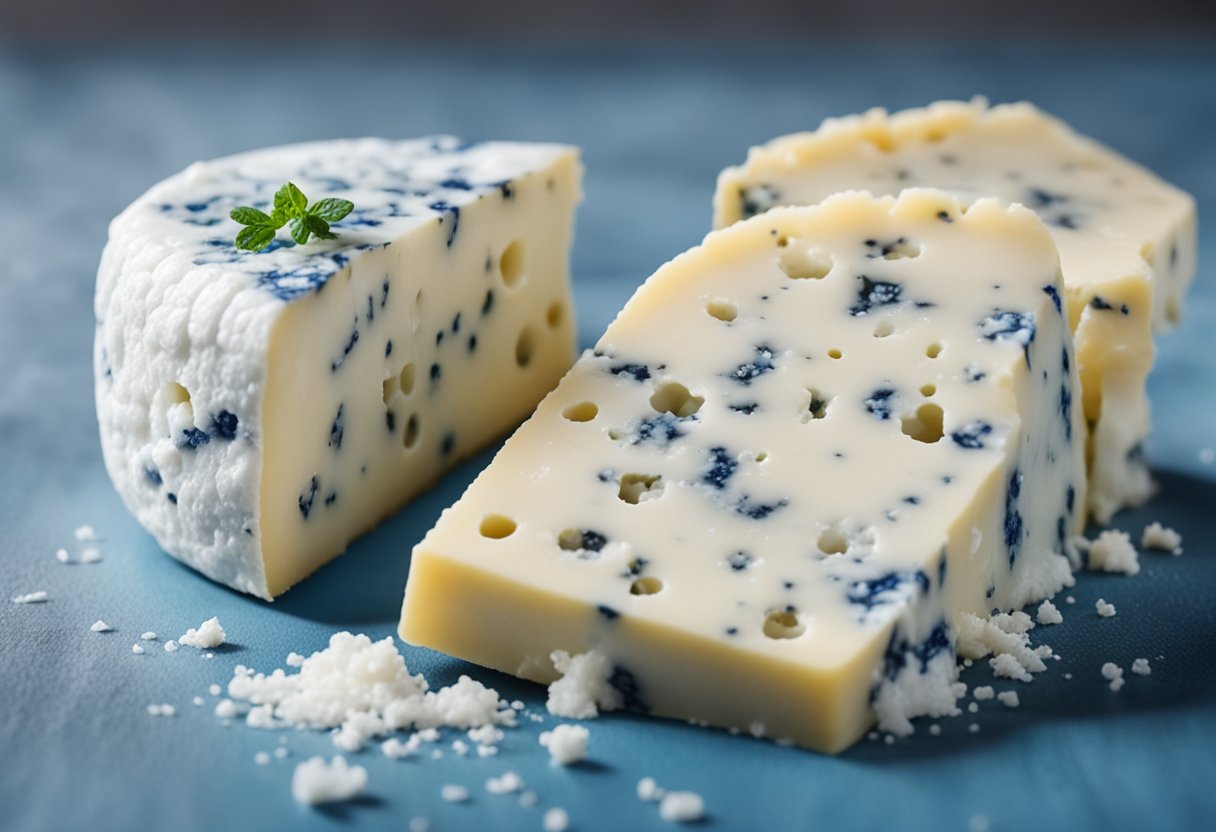
Roquefort cheese has a distinct taste and texture that sets it apart from other types of blue cheese. It has a creamy, crumbly texture that is complemented by a sharp, tangy, and slightly salty flavor.
The blue veins throughout the cheese provide a robust character and a balance between the rich creaminess and tangy piquancy.
Key Takeaways
- Roquefort cheese is a type of blue cheese made from the milk of the Lacaune breed of sheep and aged in natural caves in the Aveyron region of France.
- It has a creamy, crumbly texture and a sharp, tangy, and slightly salty flavor, with blue veins throughout the cheese providing a robust character and balance.
- Roquefort cheese is known as the “cheese of kings” and has a protected designation of origin (PDO) status.
The Making of Roquefort Cheese
I have always been fascinated by the process of making Roquefort cheese. It is a unique cheese that is made using unpasteurized sheep’s milk, which is then inoculated with the penicillium roqueforti fungus.
The cheese is then aged in natural caves, which gives it a distinct flavor and texture.
The process of making Roquefort cheese starts with the milk. The milk must be unpasteurized and come from a sheep of one of the following breeds: Lacaune, Manech, or Basco-Bearnaise.
The milk is then heated and mixed with rennet, which helps to separate the curds (milk solids) from the whey (liquid).
Once the curds have formed, they are cut into small pieces and allowed to rest for an hour or two. The penicillium roqueforti fungus is then added to the curds, which gives the cheese its distinctive blue-green mold.
The curds are then packed into molds and left to age for several months.
During the aging process, the cheese is pierced with needles to allow air to circulate and to encourage the growth of the mold. The cheese is also turned regularly to ensure that it ages evenly.
The aging time of Roquefort cheese can vary from a few weeks to several months, depending on the desired flavor and texture. The longer the cheese is aged, the sharper and more crumbly it becomes.
One of the unique aspects of Roquefort cheese is that it is aged in natural caves. The Combalou caves in Roquefort-sur-Soulzon are the most famous of these caves.
The caves provide the ideal conditions for aging the cheese, with a constant temperature and humidity level.
In conclusion, the process of making Roquefort cheese is a complex and fascinating one. From the use of unpasteurized sheep’s milk to the aging process in natural caves, every step of the process contributes to the unique flavor and texture of this delicious cheese.
Taste and Texture
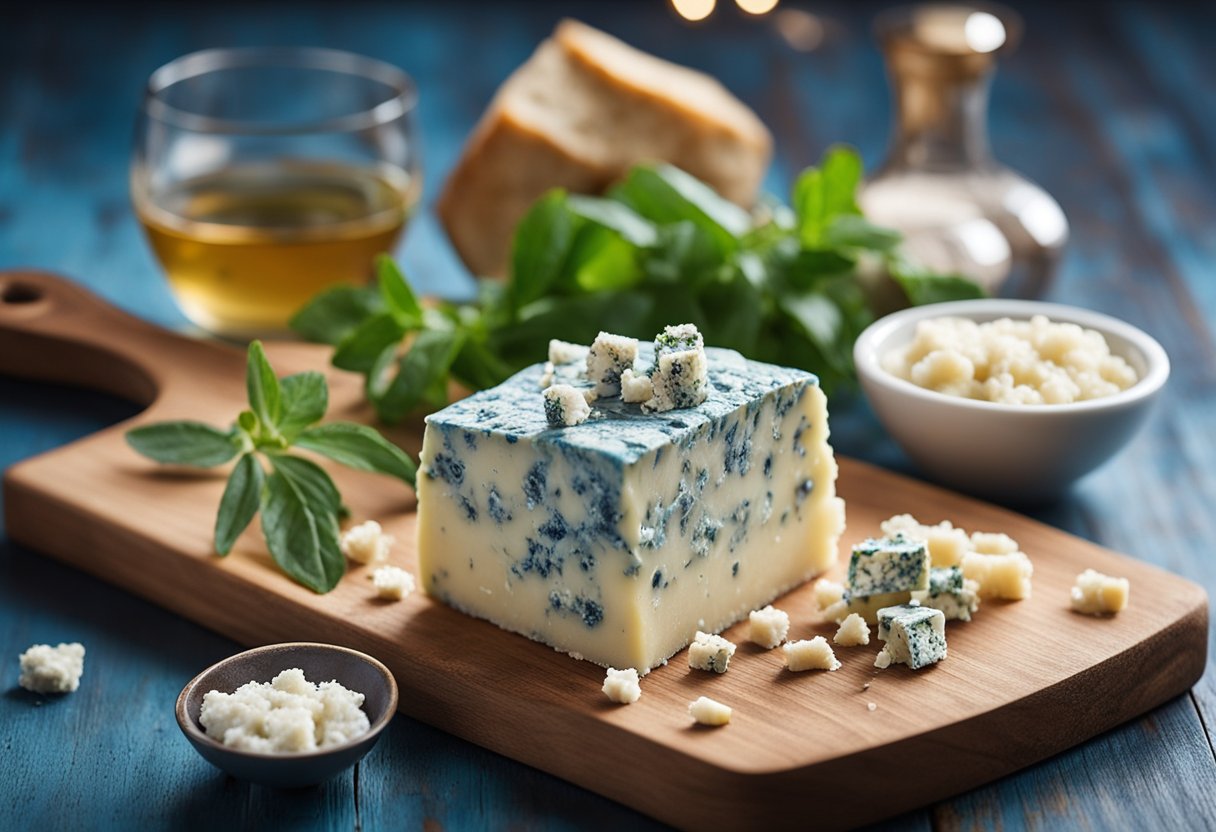
Roquefort cheese is known for its distinct flavor profile that is sharp, tangy, and slightly salty. The cheese has a pungent aroma that can be detected from a distance.
The sharp tang in Roquefort cheese comes from the blue veins that run through it. These veins are created by the Penicillium roqueforti mold that is added to the cheese during the production process.
When it comes to texture, Roquefort cheese has a moist and crumbly consistency. The cheese is a semi-hard cheese, which means that it is firm but not hard.
The texture of Roquefort cheese is unique because it ripens from the inside out. The mold breaks down the proteins and fats in the cheese, resulting in a creamy texture.
The flavor of Roquefort cheese is complex and multi-dimensional. It has buttery, caramelly, and smoky notes that complement the sharp tang of the blue veins.
The taste of Roquefort cheese is strong and lingers in the mouth. The cheese has a long finish that leaves a pleasant aftertaste.
In summary, Roquefort cheese has a sharp, tangy flavor with a moist and crumbly texture. The cheese has a pungent aroma and a complex flavor profile that includes buttery, caramelly, and smoky notes.
The taste of Roquefort cheese is strong and lingers in the mouth, with a long finish that leaves a pleasant aftertaste.
Health Benefits
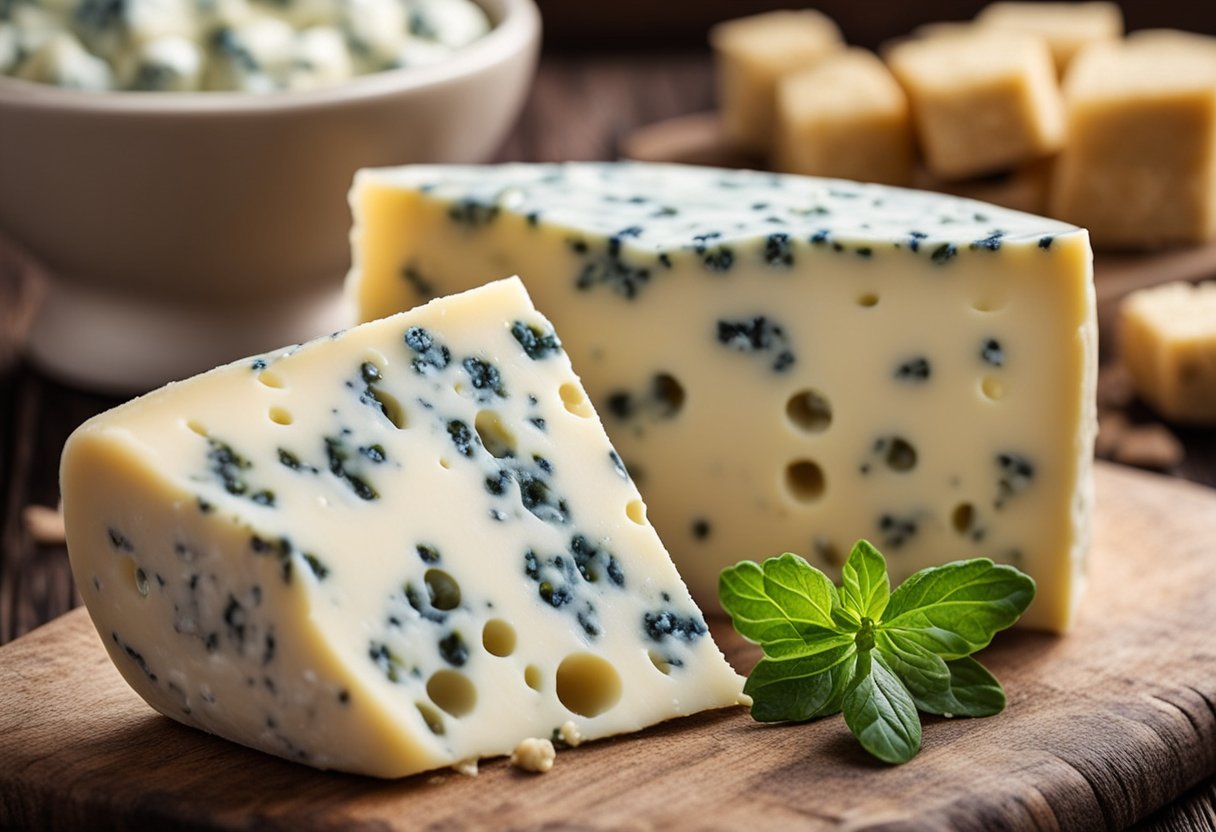
As a cheese lover, I am always curious about the health benefits of different types of cheese. Roquefort cheese, with its distinct flavor and texture, is no exception. Here are some potential health benefits of Roquefort cheese:
Rich in Protein
Roquefort cheese is a great source of protein, with about 5 grams of protein per ounce. Protein is an essential nutrient that helps to build and repair tissues in the body, as well as support the immune system. Adding Roquefort cheese to your diet can be a tasty way to increase your protein intake.
High in Fats
Roquefort cheese is also high in fat, with about 8 grams of fat per ounce. While some people may be concerned about the fat content in cheese, it is important to note that not all fats are created equal.
Roquefort cheese contains monounsaturated and polyunsaturated fats, which are considered healthy fats that can help to lower cholesterol levels and reduce the risk of heart disease.
Contains Butyric Acid
Roquefort cheese, like other blue cheeses, contains butyric acid, which is produced by the bacteria that help to create the cheese’s distinctive flavor.
While butyric acid has a strong odor and taste, it may also have some health benefits. Some studies have suggested that butyric acid can help to reduce inflammation in the body and improve gut health.
Overall, Roquefort cheese can be a delicious addition to your diet, with potential health benefits such as being a good source of protein, containing healthy fats, and containing butyric acid.
However, it is important to consume Roquefort cheese in moderation, as it is also high in sodium and calories.
Storing and Serving Roquefort Cheese
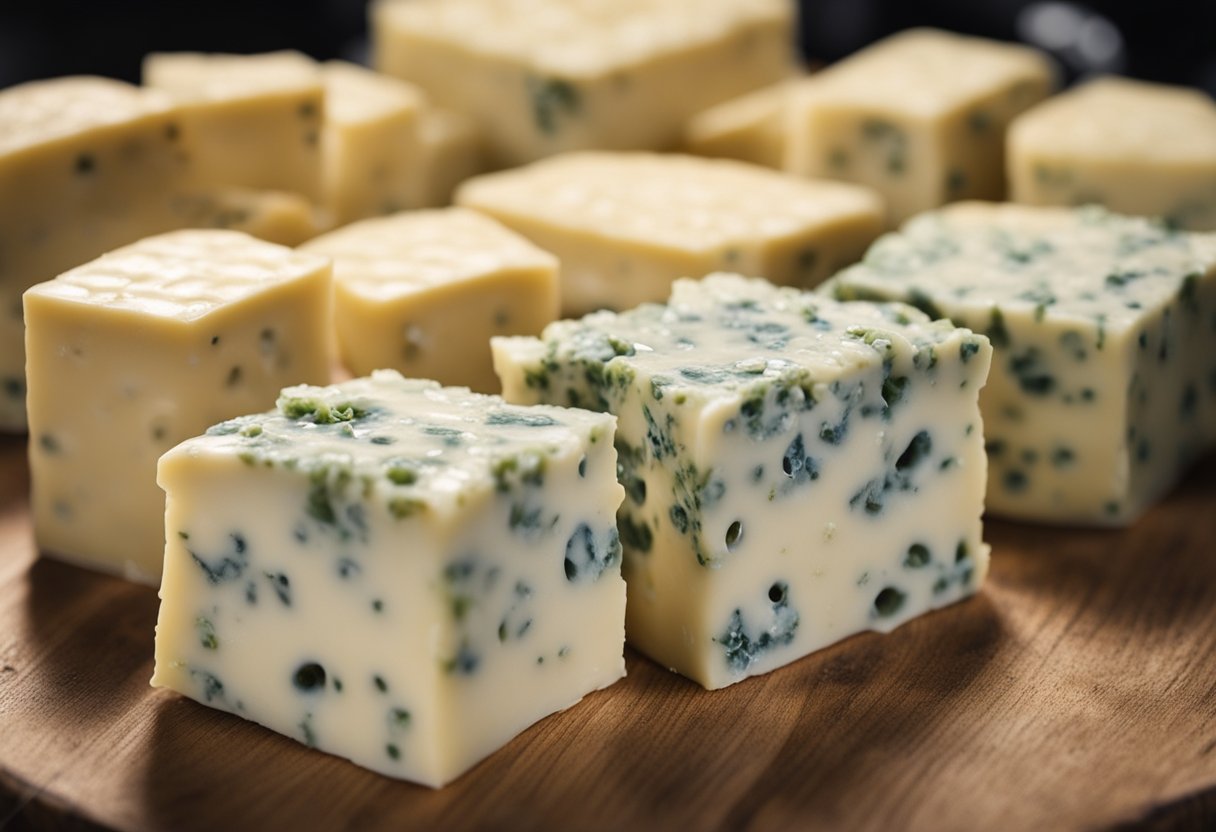
As a cheese lover, I know that storing and serving cheese properly is crucial to get the best taste and texture. Roquefort cheese is no exception.
Here are some tips on how to store and serve Roquefort cheese.
Storing Roquefort Cheese
Roquefort cheese is a soft, crumbly cheese that needs to be stored properly to maintain its texture and flavor.
Here are some tips on how to store Roquefort cheese:
- Store Roquefort cheese in the refrigerator at a temperature between 35-40°F (2-4°C).
- Wrap Roquefort cheese in foil or wax paper to prevent it from drying out and absorbing odors from other foods in the refrigerator.
- Avoid storing Roquefort cheese with other cheeses as its strong smell might affect the other cheeses’ taste.
- Roquefort cheese can last up to 2-3 weeks in the refrigerator if stored properly.
Serving Roquefort Cheese
Roquefort cheese is a versatile cheese that can be served in many ways. Here are some ideas on how to serve Roquefort cheese:
- Cheese platter: Roquefort cheese is a great addition to any cheese platter. Serve it with crackers, grapes, and walnuts for a perfect pairing.
- Cheese sauce: Roquefort cheese can be used to make a delicious cheese sauce. Melt it with some cream and butter and serve it over pasta or vegetables.
- Sandwiches: Roquefort cheese adds a tangy flavor to any sandwich. Spread it on bread and add some ham or turkey for a tasty lunch.
- Steaks and burgers: Roquefort cheese is a great addition to grilled steaks and burgers. Crumble it on top of your meat for a tasty twist.
In conclusion, Roquefort cheese is a delicious cheese that needs to be stored and served properly to get the best taste and texture. By following these tips, you can enjoy Roquefort cheese in many ways.
Pairing Suggestions

When it comes to pairing Roquefort cheese, there are plenty of options to choose from. The cheese’s complex flavor profile makes it a versatile ingredient that can be paired with a range of foods and drinks.
One classic pairing for Roquefort cheese is Sauternes wine. The sweet, fruity notes of the wine complement the tangy, salty flavor of the cheese. If you prefer red wine, a full-bodied Cabernet Sauvignon can also be a good choice.
Roquefort cheese is also delicious when paired with bread or crackers. A fresh baguette is a classic choice, but you can also try pairing it with whole-grain crackers or sourdough bread for a heartier flavor.
For a light and refreshing pairing, try mixing Roquefort cheese with salad greens and a tangy vinaigrette dressing. Blue cheese dressing can also be a good choice, as it complements the cheese’s bold flavor.
If you’re looking for a sweet and savory pairing, try pairing Roquefort cheese with dried fruit or fresh fruits like pears or apples. The sweetness of the fruit helps to balance out the cheese’s salty and tangy notes.
Roquefort cheese can also be used as a topping for meat dishes like steak or roasted chicken. The cheese’s bold flavor can add a delicious twist to savory dishes.
For a unique dessert pairing, try pairing Roquefort cheese with a sweet tart or pie. The cheese’s salty notes can complement the sweetness of the dessert, creating a unique and delicious flavor combination.
Overall, Roquefort cheese is a versatile ingredient that can be paired with a range of foods and drinks. Whether you prefer sweet or savory pairings, there’s a Roquefort cheese pairing out there for you to enjoy.
Roquefort Cheese in Recipes
I love using Roquefort cheese in my recipes. Its sharp, tangy, and salty flavor adds a unique taste to any dish. Here are some ways I like to use Roquefort cheese:
Salads
Roquefort cheese is a great addition to any salad. Its crumbly texture and strong flavor pair well with bitter greens like arugula or endive.
I like to make a simple salad with mixed greens, sliced pears, walnuts, and crumbled Roquefort cheese. The cheese adds a nice salty contrast to the sweetness of the pears.
Pasta
Roquefort cheese is a great way to add flavor to pasta dishes. I like to make a simple pasta with olive oil, garlic, and Roquefort cheese.
The cheese melts nicely and coats the pasta, creating a creamy sauce. You can also add some cooked chicken or shrimp to make it a complete meal.
Dressings
Roquefort cheese is a classic ingredient in many dressings. Its sharp flavor pairs well with creamy dressings like ranch or blue cheese.
I like to make a simple Roquefort dressing with crumbled cheese, mayonnaise, buttermilk, and a splash of vinegar. It’s a great way to add flavor to a simple salad.
Italian Dishes
Roquefort cheese isn’t traditionally used in Italian cuisine, but it can still be a great addition to many dishes. I like to use it in place of Parmesan cheese in pasta dishes. Its strong flavor adds a unique twist to classic Italian flavors.
Overall, Roquefort cheese is a versatile ingredient that can add a lot of flavor to many different dishes. Whether you’re making a salad, pasta, dressing, or Italian dish, Roquefort cheese is a great way to add a unique twist to your favorite recipes.
Comparisons and Substitutes

When it comes to Roquefort cheese, there are a few other blue cheeses that are similar in taste and texture. Stilton, a British blue cheese, is often compared to Roquefort in terms of flavor, but it is milder in comparison.
Gorgonzola, an Italian blue cheese made from cow’s milk, is also a popular substitute for Roquefort. Cabrales, a Spanish blue cheese, is another option that is similar in taste and texture.
One of the key factors that sets Roquefort apart from other blue cheeses is its sweetness. Roquefort has a distinct sweetness that is not found in other blue cheeses.
This sweetness comes from the penicillium glaucum mold that is used to make the cheese. This mold is unique to Roquefort and is found in the caves of Roquefort-sur-Soulzon in France, where the cheese is aged.
While Roquefort is a French cheese, it is also produced in other countries, including the United States. However, these cheeses may not have the same flavor and texture as the original Roquefort.
In Europe, Roquefort is often referred to as the “King of Cheeses” or the “Cheese of Kings and Popes.” It has a long history and was even mentioned by Pliny the Elder in his writings.
If you are looking for a substitute for Roquefort cheese, there are a few options to consider. One option is Saint Agur, a French blue cheese that is similar in taste and texture to Roquefort.
Another option is Danish Blue, which is made from cow’s milk and has a milder flavor than Roquefort.
In terms of texture, Roquefort has a crumbly and moist texture that is similar to feta cheese. It also has a distinct mushroom-like aroma that is characteristic of the penicillium glaucum mold.
If you are looking for a substitute that has a similar texture, Brighton Blue Cheese, a British blue cheese, is a delicious and unique option.
Overall, while Roquefort cheese is a unique and delicious cheese, there are a few other blue cheeses that are similar in taste and texture.
When looking for a substitute, consider the sweetness, texture, and flavor of the cheese to find one that will work well in your recipe.
Historical Significance
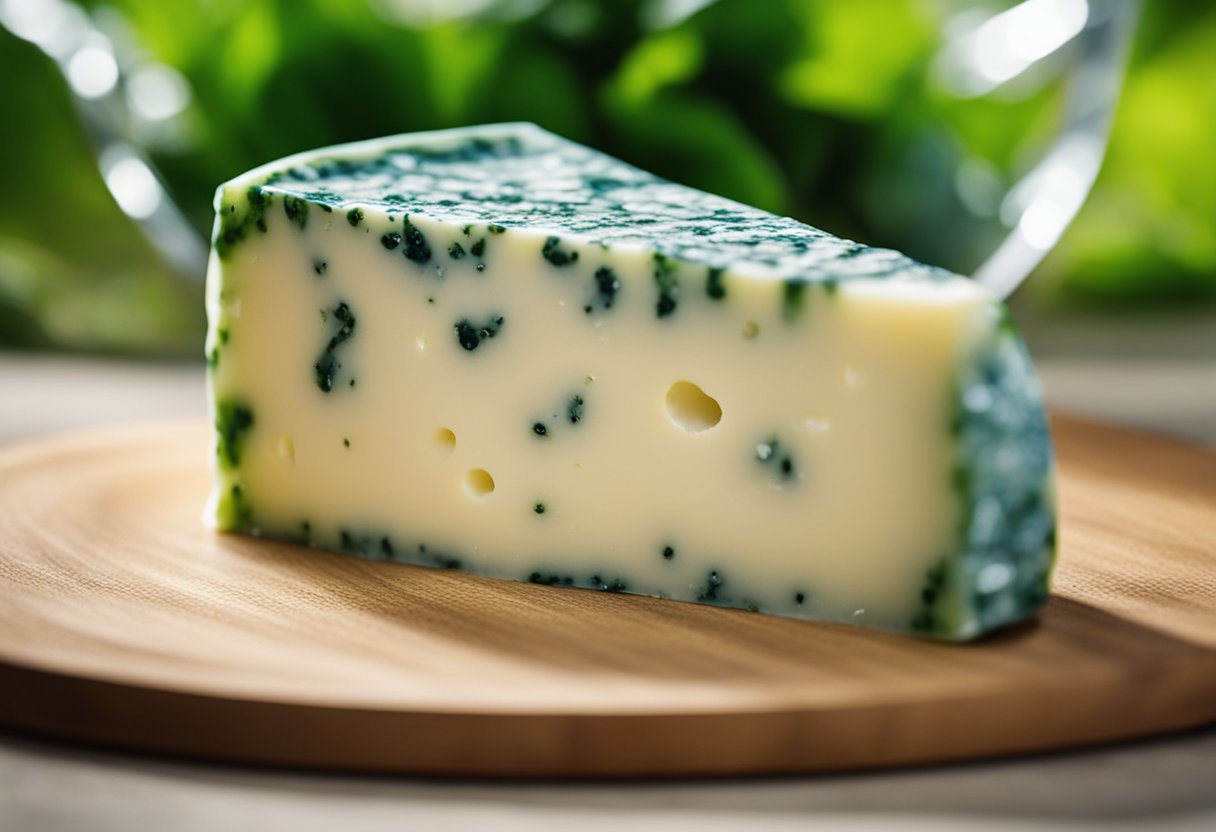
Roquefort cheese is one of the oldest known cheeses in the world. According to legend, the cheese was discovered by a shepherd who left his lunch of bread and ewe’s milk cheese in a nearby cave to chase after a beautiful girl.
When he returned a few months later, the mold Penicillium roqueforti had transformed his plain cheese into Roquefort.
The cheese has been enjoyed for centuries and is often considered the cheese of kings and popes. Pliny the Elder, a Roman author, praised the cheese in his writings, and it was even mentioned in the Bible.
During the Middle Ages, Roquefort cheese was considered a luxury item and was reserved for the upper classes.
In the 15th century, the cheese was granted the status of a protected product by King Charles VI of France, making it one of the first cheeses to receive such recognition.
Today, the designation Roquefort is still protected by French law and can only be produced in specific regions of France using strict methods.
Roquefort cheese has played a significant role in French culture and cuisine throughout history. It is often used in traditional dishes such as salads, omelets, and quiches.
The cheese’s tangy, salty flavor and creamy texture have made it a favorite among cheese lovers worldwide.
Frequently Asked Questions
What are the differences between Roquefort, blue cheese, and Gorgonzola?
Roquefort, blue cheese, and Gorgonzola are all types of blue-veined cheeses. Roquefort is made from sheep’s milk in the Roquefort-sur-Soulzon region of France, while blue cheese can be made from cow’s, sheep’s, or goat’s milk and is produced in various regions around the world.
Gorgonzola is an Italian blue cheese made from cow’s milk. Roquefort has a distinct flavor and aroma due to the specific mold used in its production, while blue cheese and Gorgonzola have a milder taste and aroma.
What is the best Roquefort cheese?
The best Roquefort cheese is a matter of personal preference. However, some of the most well-known and highly regarded Roquefort producers include Société, Papillon, and Carles.
What does blue cheese smell like?
Blue cheese has a pungent, strong aroma that some people find unpleasant. The odor is caused by the mold that is used in the cheese’s production.
What is the difference between blue cheese and Roquefort cheese?
The main difference between blue cheese and Roquefort cheese is the type of mold used in their production.
Roquefort cheese is made with a specific strain of mold, Penicillium roqueforti, which is only found in the caves of Roquefort-sur-Soulzon in France. Blue cheese, on the other hand, can be made with several different strains of mold.
What is special about Roquefort cheese?
Roquefort cheese is special because of its unique flavor and aroma, which are the result of the specific mold used in its production. The cheese has a distinct sharpness and tanginess, with subtle notes of sweet and nutty flavors.
Roquefort is also protected by the French AOC (Appellation d’Origine Contrôlée) designation, which means that it can only be produced in a specific region of France using specific methods.
Is Roquefort the same as Gorgonzola?
Roquefort and Gorgonzola are both blue-veined cheeses, but they are not the same. Roquefort is made from sheep’s milk in France, while Gorgonzola is made from cow’s milk in Italy.
The two cheeses have different flavors and aromas due to the specific molds used in their production.







